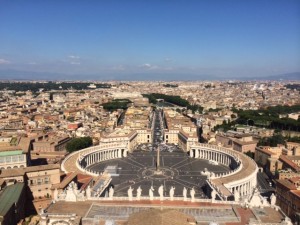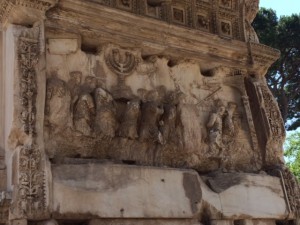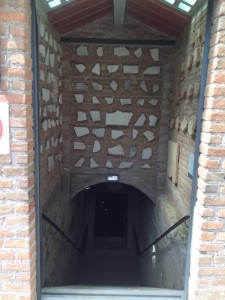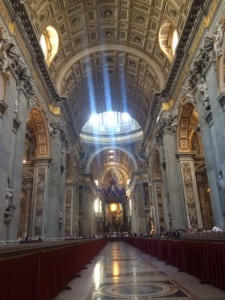Erik here, writing from my sister’s home in Carlisle, Mass, to which we’ve returned after leaving Rome yesterday afternoon. The snow and frigid temperatures that greeted us when we arrived here on March 4th at the start of our sabbatical journey have been replaced by verdant hardwood forests and mid-90 degree heat with high humidity. In March we walked on frozen Walden Pond; today we sought refuge from the heat there, enjoying a swim in Walden’s waters.
It feels good to be back in familiar territory, even while we continue the process of unpacking what we’ve experienced over the past four months of this extended journey. There’ll be no summing up in this post—we’ll be sorting through all this for many, many moons to come—but I did want to reflect a bit on our Roman experience particularly as it relates to the Christian story.
REFLECTION 1: Imperial Rome was a juggernaut of incredible proportions.
The geographic reach of imperial Rome during its heyday was truly astounding. From Hadrian’s Wall near the Scottish/British border in the north, and throughout France and Italy we continually encountered evidence of that reach.
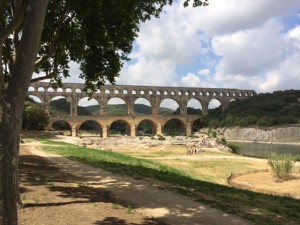 At Pont du Gard in southern France we encountered one of the most astounding symbols of Rome’s calculated ingenuity—the remains of an aqueduct system which delivered water from freshwater springs near Uzès to the city of Nîmes, over 50 kilometers (31 miles) to the south. Over its course, the water in the aqueduct passed over a series of underground and above ground covered structures to the catchment basin in Nîmes, maintaining a consistent drop in elevation of 10 inches per kilometer and delivering 50-100 gallons of fresh water per second to the city’s inhabitants. The aqueduct bridge spanning the Gard River (Pont du Gard), 900 feet long and 160 high, was an astounding achievement. All these centuries later it continues to astound with its beauty, massive proportions, engineering prowess, and the organizational systems that enabled such a project to be realized. Aqueducts such as this, along with the famous Roman road system that stretched throughout the Empire and the temples, theatres, and amphitheaters we touched along our way, testify to Rome’s reach and control of territories and peoples.
At Pont du Gard in southern France we encountered one of the most astounding symbols of Rome’s calculated ingenuity—the remains of an aqueduct system which delivered water from freshwater springs near Uzès to the city of Nîmes, over 50 kilometers (31 miles) to the south. Over its course, the water in the aqueduct passed over a series of underground and above ground covered structures to the catchment basin in Nîmes, maintaining a consistent drop in elevation of 10 inches per kilometer and delivering 50-100 gallons of fresh water per second to the city’s inhabitants. The aqueduct bridge spanning the Gard River (Pont du Gard), 900 feet long and 160 high, was an astounding achievement. All these centuries later it continues to astound with its beauty, massive proportions, engineering prowess, and the organizational systems that enabled such a project to be realized. Aqueducts such as this, along with the famous Roman road system that stretched throughout the Empire and the temples, theatres, and amphitheaters we touched along our way, testify to Rome’s reach and control of territories and peoples.
Mythologically speaking, Romans understood themselves to be descendants of Mars, the god of war, and when you’re in Rome, you can see how that core belief undergirds the city and its greatest monuments. Ancient sources testify that during the first 100 days of games in the newly inaugurated Colosseum in 80 AD, 9000 animals were killed; and that each year as daily spectacles were staged there, thousands of gladiators (and condemned prisoners) lost their lives. The structure itself was erected just after the Judean Wars, which culminated with the destruction of Jerusalem and the Temple in 70 AD; in fact Jewish exiles from that war provided much of the slave labor needed to build it. A few hundred meters from the Colosseum, you can still see the Arc of Titus which celebrates that Roman victory and depicts Jewish slaves carrying sacred Temple treasures—now Roman war booty—from Jerusalem back to Rome. Imposing arcs like this one, which celebrated significant military victories and ushered Roman generals into the Roman Hall of Fame, were a dominant feature of the ancient city. (Including the one erected by Constantine—standing near the Colosseum— following his victory over Maxentius; a victory that presaged his conversion to the Christian faith.)
Reflection 2: Going against the grain of this Empire by following the life and teachings of a poor Jewish carpenter was risky business. The contrast between the Roman way and the Jesus Way of being in the world has been brought home to me as never before.
One of the most moving experiences for me in Rome was our visit to the catacombs at Callixtus. Located outside the ancient city along the Appian Way, Callixtus became a burial place for early Christians during the 2nd century after Emperor Commodus granted Christians the right to bury.
- Burials had to be outside the city walls.
- The means of disposing the bodies would have to be sanitary.
- The burials would have to be on private property.
The least expensive land was this non-arable expanse of tufa so that’s where Christians began to bury their dead. Tufa, consisting of consolidated volcanic ash, was too soft and liable to collapse when first dug. But with exposure to air, it hardens, and so it proved to be an ideal place for burials, to the point that eventually a half million Christians were eventually buried there.
As the Christian community developed these tombs (the main architect assigned to this task was named Callixtus and the name stuck), digging down from the surface, adding skylights and ventilation shafts, they eventually reached down 20 meters into the tufa rock. 95% of the tombs were for individuals, but a small percentage were carved out for families or extended families. During this era when Christian teachings were anathema to the Empire’s interests and Christians were labeled “atheists” for their failure to participate in Roman cultic practices, the catacombs became places apart and the larger family burial rooms provided spaces and the opportunity to pray. The catacombs were not secret places, however. They were well known, and this fact was not lost on the Roman authorities. The Way practiced by Christians was still illegal and, at times, violently opposed in the second and third centuries. If caught in the act of prayer, you could be summarily executed. The story of early martyrs testifies to this.
While walking through these subterranean passageways we saw early Christian symbols painted on the walls and ceilings of some of the family tombs: Fish, shepherds, lamps, doves, anchors, doves, and others. These symbols, many of which had reference points in Roman culture, became infused with new meaning as Christians used them to express their burgeoning faith in a God/Man who had suffered the worst kind of death Rome ever conceived—crucifixion—and rose above it. The Jesus these symbols celebrate commanded his followers to love—not to slaughter—their enemies. To become one of his followers was to place oneself on a clash course with the mightiest Empire the world has ever known. What courage it took! What Spirit to persevere and endure against all odds, knowing that the ultimate victory belonged to Christ alone!
Reflection 3: All of this changed when Christianity became legal. When Constantine declared Christianity legal and later called the first ecumenical council, the church began moving from the margins to the center of Roman culture; from the underdog to the overlord. In that process, many of the systems that had sustained Rome over the centuries became features of the fledgling institutional church. What followed as church structures, doctrines, and hierarchy developed over ensuing centuries was an ecclesia that more and more mirrored the Empire.
The upshot: the fingerprints of ancient Rome are all over the Western Church as it developed institutionally, and that heritage is still present with us today. Like the Roman Empire, that imperial church is dying. In many of the places we visited that empire-church has become little more than a museum piece and it’s hard to imagine a sustainable future for the kind of vision they once embodied. Still, there is evidence that something new is emerging from the old. We found this was particularly true among some of the communities with Celtic Christian roots. Whether it will prove strong enough to revitalize the church in Western Europe remains to be seen.

